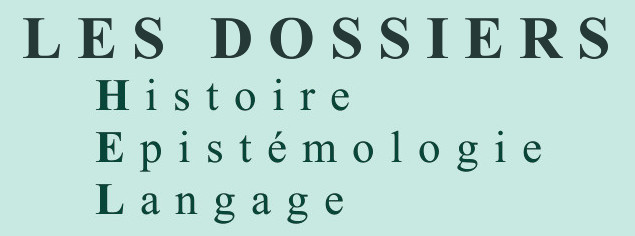 Dossiers d’HEL n°7
Dossiers d’HEL n°7
Lecture vernaculaire de textes classiques chinois
Reading Chinese Classical texts in the Vernacular
Numéro dirigé par John Whitman et Franck Cinato
SHESL 2014
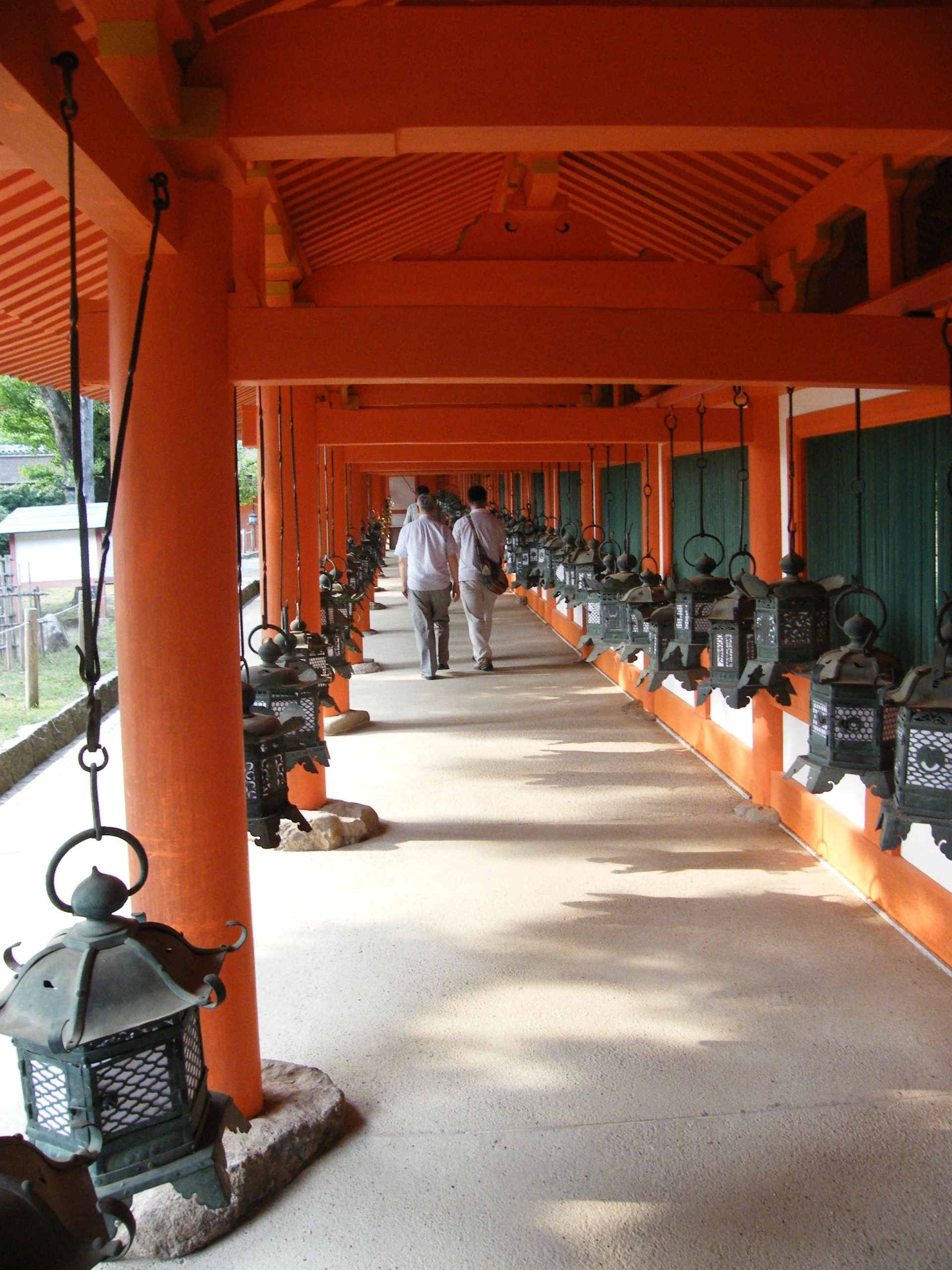 Workshop 30/07/2013 à Tokyo : résumé des communications
Workshop 30/07/2013 à Tokyo : résumé des communications
La journée du 30 juillet 2013 a été l’occasion pour les chercheurs invités de présenter leur travaux afin d’ouvrir les discussions qui ont suivi. Le lecteur trouvera ici un résumé des communications de Pádraic Moran, Alderik H. Blom, Andreas Nievergelt et Franck Cinato.
Medieval glossed texts in the Irish tradition
Pádraic Moran (padraic.moran@nuigalway.ie)
National University of Ireland, Galway
Old Irish is the designation given to the earliest phrase of the Irish language for which a substantial corpus of texts exists. This corpus consists mostly of glosses written between the lines and in the margins of Latin manuscripts from the eighth and ninth centuries ad, nearly all of which are preserved outside of Ireland on the European continent. Old Irish glosses alternate freely with Latin glosses on these pages and together they explicate mostly Christian scripture, but also some secular texts from the Graeco-Roman tradition. This paper takes as a case study a ninth-century manuscript of Priscian, a Latin grammarian who lived in Constantinople in the sixth century. The manuscript, now in St Gall in Switzerland (Stiftsbibliothek, ms 904), contains some 3,500 Old Irish glosses, c. 5,900 Latin glosses and c. 3,000 additional symbol marks. The papers surveys a typology of these glosses, including syntax glosses, lexical glosses, morphological glosses, glosses marking proper nouns, etymological glosses and longer commentary glosses. Particular attention is given to the interaction of Classical (Latin) and vernacular (Irish) languages in the glosses. The paper also gives an account of the transmission of the Priscian gloss corpus and explains the rationale behind a recent digital edition (www.stgallpriscian.ie).

St Gall, Stiftsbibliothek, ms 904, p. 26b. Priscian’s Latin grammar, copied in 851, with Latin, Old Irish and symbol glosses. (Image from <www.cesg.unifr.ch>.)
Glossing the Psalms: Form and Function of Early Medieval Vernacular Glosses
Alderik H. Blom (alderik.blom@mod-langs.ox.ac.uk)
University of Oxford, UK
The present paper results from a comparative study of the types of vernacular glossing which the Latin Psalter received from the eighth to the late eleventh centuries A.D. in the North-West of Europe. Written uses of vernaculars such as Old Irish, Old English, and Old High German are compared and contrasted in their interface with one specific Latin text. This particular paper illustrates several aspects of the typology and the pragmatic context of such vernacular glossing. It argues for a typology which focuses not so much on the semantic content of a gloss (exegetical, ecdotic, grammatical, etc.) but on the notion of Textnähe (‘text-proximity’), namely, the degree of grammatical (in)dependence of a gloss from its base text. Therefore, whereas substitution and supplement glosses form part of the metasyntax of a base text, commentary glosses generally do not. These distinctions enable us to establish to what extent a gloss is ‘part’ of the base text and what the intended reading-strategy must have been, distinguishing between horizontal, that is, independent of the base text, and vertical reading-strategies, namely very much dependent on the base text. This functional typology is subsequently illustrated with examples from the Latin and Old Irish glossing on the commentary on the Psalms (written ca. 800) now kept in the Ambrosian Library in Milan. The second part of the paper gives an account of the pragmatic context of vernacular glossing, taking as a case study a ninth-century Latin Psalter with a continuous gloss in Old High German, the so-called Oldalemannic Psalterfragments. The form, function, and intended reading-strategy of this bilingual text is studied through a detailed analysis of the punctuation of the Latin and vernacular layers.
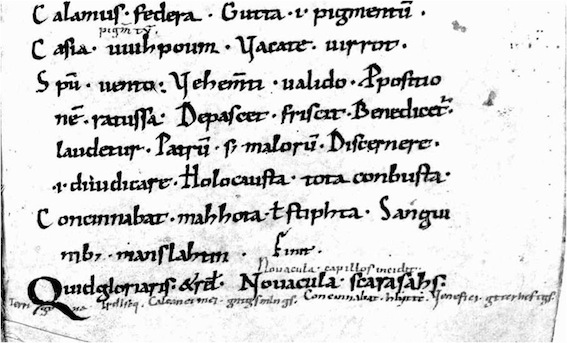
A biblical glossary of the «M» family in Münich, Bayerische Staatsbibliothek, Clm 19440, p. 191, dated around A.D. 1000, here showing glossae collectae on Psalms 44:2 to 57:6.
Scratched – enciphered – shortened. Old High German Glosses and their functional questions
Andreas Nievergelt (anievergelt@hotmail.com)
Université de Zürich
Old High German, the earliest recorded stage of the German Language, is available in various types of sources. The broadest written records are represented by the glosses. While the early research in German philology treated the Old High German glosses mainly from the point of view of language history and culture history, medial and functional issues have been taken recently more and more into consideration, for example: who wrote the glosses, how, where and why? At the same time, the medial representation of the glosses is considered as meaningful for their functionality. From a variety of external characteristics, three of them stand out: stylus technique, cryptography and abbreviation method. Inconspicuous and as is the rule not copied stylus glosses point out in their appearance to individual usage and with it to a certain application contexts going beyond didactics and organized storage of knowledge. On the other hand, the overtly presented cryptographic glosses, which are written with a stylus only in rare cases, tend to refer to activity contexts such as teaching, during which knowledge would be presented and passed on. Finally, the abbreviations demonstrate a plurality of methods between hermetically individual, innovative and conventionalized forms. Altogether, it becomes clear that the medial variety of the Old High German glosses must be related to intentional or functional differentiation, which opens up new possibilities of discovering the vernacular language.
Althochdeutsch, die früheste schriftlich überlieferte Stufe der deutschen Sprache, liegt in verschiedenen Quellentypen vor. Die breiteste Überlieferung bieten die Glossen. Während die ältere germanistische Forschung die althochdeutschen Glossen hauptsächlich sprach- und kulturgeschichtlich auswertete, sind in jüngerer Zeit verstärkt mediale und funktionale Fragen in den Blick genommen worden wie: Wer hat wie, wo und wozu glossiert. Dabei wird die mediale Repräsentation der Glossen als bedeutungsvoll für ihre Funktionalität betrachtet. Aus einer Vielfalt an äusseren Merkmalen ragen drei verbreitete heraus: Die Griffeltechnik, die Kryptographie sowie Kürzungsverfahren. Die unscheinbaren, in der Regel nicht kopialen Griffelglossen verweisen in ihrem Erscheinungsbild auf einen persönlichen Gebrauch und damit auf bestimmte Betätigungskontexte ausserhalb von Didaktik und organisierter Wissensspeicherung. Dagegen zeigen die eigentümlich ostentativ präsentierten geheimschriftlichen Glossen, die nur in Einzelfällen mit Griffel eingetragen sind, tendenziell auf Handlungsrahmen wie den Unterricht, wo Wissen vorgezeigt und weitergegeben wurde. Die Kürzungen schliesslich weisen eine Pluralität an Verfahren zwischen hermetisch-individuellen, innovativen und konventionalisierten Formen auf. Insgesamt wird deutlich, dass die mediale Vielfältigkeit der althochdeutschen Glossen mit intentionaler bzw. funktionaler Ausdifferenzierung zu verbinden ist, worin sich neue Möglichkeiten öffnen, die Rolle der Volkssprache zu ergründen.
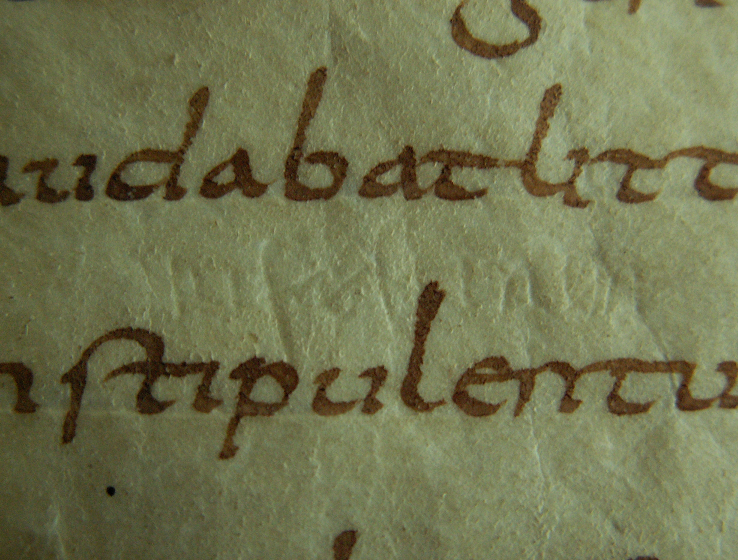
Zürich, Zentralbibliothek Ms. C 59, Aldhelmus, De laudibus virginum, glose en ancien vieil-allemand infestenon, écrite à la pointe sèche. St-Gall, IXe siècle.
Grammatici : magistri-glossatores
Franck Cinato (cinato.franck@orange.fr)
HTL. CNRS, UMR 7597
Grammarians, master-glossators
1. In the heterogeneous linguistic context of the eighth and ninth centuries, where the renovatio of Latin is an object of universal concern, grammarians had a decisive influence on the intellectual approach generally applied to texts, sacred as well as profane. Their attitude toward texts determined how the books (manuscripts) were produced and used.
2. On the subject of the use of the Liber glossarum in Priscian studies, this paper offers some insights on the close relationship that existed between the glossed texts and the tools that were used for this study.
Les grammairiens, maîtres-glossateurs.
1. Dans le contexte linguistique hétérogène des VIIIe et IXe siècles où la renovatio du latin est l’objet de toutes les attentions, les grammairiens ont exercé une influence décisive quant à l’approche intellectuelle appliquée globalement aux textes, sacrés comme profanes. Leur attitude face aux textes a déterminé la façon dont les livres (manuscrits) ont été produits et utilisés. 2. Sur le thème de l’utilisation du Liber glossarum dans l’étude Priscien, la présente contribution offre quelques réflexions sur l’étroite relation qui a existé entre les textes glosés et les outils utilisés à cette fin.
1. Réflexions épistémologiques. La diversité d’intérêts et d’objectifs des gloses — au sens d’outils polymorphes conçus et développés par les grammairiens médiévaux —, révèle le rôle capital qu’elles ont joué dans la pédagogie et l’élaboration de la « science » médiévale. Les gloses constituent le socle d’un ensemble de stratégies (« sémiotiques » et verbales) — que nous qualifierons de glossographiques — visant à la transmission du savoir. Une redéfinition restreinte du terme ‘glose’ est l’occasion de proposer trois axes de réflexions visant à caractériser ce matériel spécifique en fonction de leurs mécanismes de diffusion, de leur contenu et des objectifs du personnel impliqué dans les différentes étapes de production des connaissances.
2. Relations entre le Liber glossarum et Priscien : une linguistique encyclopédique. Le Liber glossarum, vaste entreprise lexicographique de la fin du VIIIe siècle, se trouve diffusé tandis que l’impressionnante et novatrice Ars grammatica de Priscien commençait à susciter l’intérêt des maîtres carolingiens. Au cours du IXe siècle, les deux textes vont se côtoyer, presque par nécessité, en raison de caractéristiques convergentes. L’évolution quantitative du péri-texte attaché à Priscien, ainsi que la diversification de son contenu, permettent de juger de amplification de l’enseignement linguistique — qui déborde largement du cadre strict de la grammaire latine par ses visés encyclopédiques — soutenue par l’élaboration de nouveaux outils de travail, comme les glossaires spécialisés (glossae collectae). À partir du milieu du IXe siècle, le Liber glossarum apparaît plus adapté que les anciens glossaires pour expliquer le riche vocabulaire de Priscien. Vers le fin du siècle, de nouveaux petits glossaires incorporent une composante de lemmes et gloses sur Priscien accentuant encore la circularité du cheminement des gloses : des marges aux glossaires et des glossaires aux marges. Durant les décennies et les siècles qui suivent, on observe des tentatives ponctuelles d’enrichissement du Lib. gl. pour lesquelles, entre autres, Priscien et les gloses générées par son texte ont été sollicités. Dans le cadre de la lecture de Priscien, cette relation entre « livres glosés et livres de gloses » est illustré par un exemple tiré des travaux d’un intellectuel de l’époque de Charles le Chauve, Heiric d’Auxerre (841 – † après 883 ?).
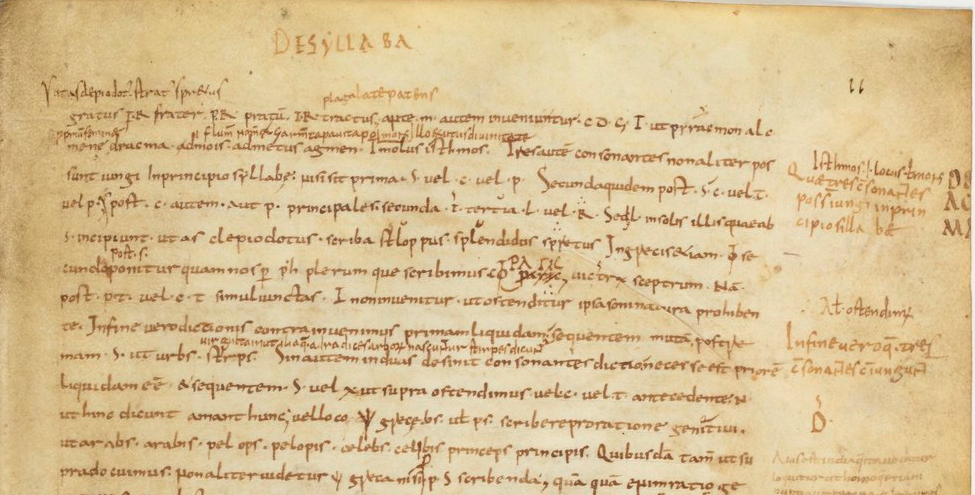
Paris, BnF, lat. 7496. Copie de l’Ars Prisciani glosée par le maître auxerrois Heiric, vers 860-870.
![]() Les oeuvres contenues dans les Dossiers d’HEL sont mis à disposition selon les termes de la Licence Creative Commons Attribution – Pas d’Utilisation Commerciale – Partage dans les Mêmes Conditions 4.0 International.
Les oeuvres contenues dans les Dossiers d’HEL sont mis à disposition selon les termes de la Licence Creative Commons Attribution – Pas d’Utilisation Commerciale – Partage dans les Mêmes Conditions 4.0 International.
